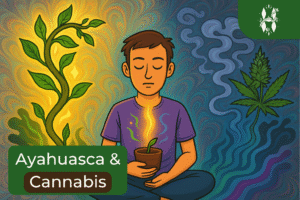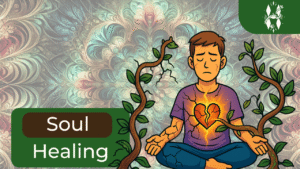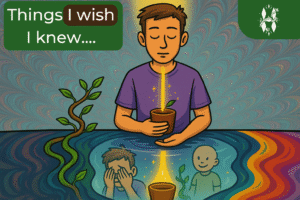You might have heard the term “Taita” before in Colombia, in combination with Ayahuasca (Yagé) and you might be asking yourself, what does Taita mean? When does somebody become a Taita? This blog answers those questions, exploring the meaning of Taita, the responsibilities they have, and interesting legends that surround them.
Key takeaways:
Taitas are indigenous spiritual leaders and healers – considered as doctors in Amazonian cultures. They are responsible for guiding Ayahuasca ceremonies and preserving traditional knowledge and practices.
The journey to becoming a Taita is long and rigorous, involving decades of training, personal sacrifice, and deep commitment to serve others and help them heal.
Taitas are deeply connected to the spirit of Ayahuasca and the natural world. They emphasize the sacredness of Ayahuasca.
Table of Contents
Where does the word Shaman come from?
Many Westerners refer to the person facilitating an Ayahuasca ceremony as an “Ayahuasca shaman.” However, the word “shaman” actually originates from Siberia, specifically from the Tungus-speaking peoples of Siberia. The term has been widely adopted in the West to describe indigenous healers and spiritual leaders from various cultures.
In the context of Ayahuasca, the traditional “medicine givers” in Colombia and other regions do not typically consider themselves shamans, nor is it a word they are accustomed to using. However, with the growing interest from Westerners and the increasing global recognition of Ayahuasca practices, these healers are beginning to recognize the term “shaman” more frequently. Despite this, they retain their unique cultural identities and traditional titles, such as Taita, which hold significant cultural and spiritual meaning within their own communities.
Must read blog: Ayahuasca Healing
The Importance of Taitas from the Amazon
The Amazon rainforest is a treasure trove of medicinal plants, yet only about 0.5% of its flora has been studied. Despite this small percentage, an impressive 25% of Western medications are derived from Amazonian plants. This highlights the untapped potential of the jungle’s healing powers.
Traditionally, Taitas and Mamas (the female equivalent of Taitas) would drink Ayahuasca to connect with the Amazon and the spirits of the plants. In this extraordinary state of consciousness, they could access knowledge about different plants and how to use them for healing. This wisdom has been passed down through generations, making a Taita a traditional doctor of the Amazon, with Ayahuasca as their primary medicine.
Powerful Taitas are known to cure diseases that many Western medicines struggle with, showcasing their profound healing abilities. However, Taitas humbly acknowledge that it is the “Great Spirit” doing the healing, with them merely facilitating the process. They call in the spirits, heal energetic misalignments, and cleanse the body with various remedies. Ultimately, the healing depends on the “Great Spirit” and the spirit of the person receiving the treatment.
Who is a Taita?
Several factors determine whether a person can be considered a Taita, and no single aspect is enough by itself. A Taita is a deep friend of Ayahuasca, involved in growing, cooking, and sharing his own Ayahuasca. This close relationship with the medicine is important. Beyond Ayahuasca, a Taita also possesses extensive knowledge of the Amazon’s flora and fauna, as well as other healing plants.
Recognition by the elders of the community is necessary for someone to be considered a Taita. This recognition can occur in various ways. In the Inga tribe, for example, the elders sit with the aspiring Taita, and during their Ayahuasca visions, they must see the crown of Ayahuasca on the top of the person’s head. This vision is a significant sign of the individual’s readiness and connection to the medicine. In other tribes, the aspiring Taita is given specific tasks to heal various patients within a set period. If successful, they are rewarded with the title of Taita, marking their competence and dedication.
Becoming a Taita is a great honor within indigenous traditions, reflecting a deep commitment to healing and spiritual guidance. “Taita” is not just a mark of skill but a recognition of one’s dedication to the community and the practices of Ayahuasca. It signifies a lifetime commitment to learning, healing, and serving others, and there is a profound respect and responsibility that comes with the role.
For a musical perspective on the Ayahuasca crown, you can listen to a song by Nicolas Losado about the “corona de yagé” here.
Find out if Ayahuasca is right for you
- Will you be safe physically and emotionally?
- How will you be supported in the ceremony?
- How do the facilitators handle difficult situations?
- How will you be able to process the experience?
- You want change, but will your life be unrecognizable after Ayahuasca?
+ 13 things to consider before drinking Ayahuasca?
Responsibility of Taitas
Taitas are individuals with a significant amount of “spiritual” power, and with this power comes great responsibility. They are tasked with guiding their community, helping the sick, and preserving the rainforest. Taitas are often the go-to figures in their communities for help and advice. Their role extends beyond the spiritual, stretching to social and environmental responsibilities as well.
One prominent example is Taita Querubin, a major Taita who recently passed away at the age of 102 (some say he was even 107 years old). He was known not only for his healing abilities but also for his advocacy for indigenous rights. Taita Querubin even spoke at the United Nations, highlighting the importance of protecting indigenous cultures and their knowledge. His life and work exemplify the profound responsibilities that come with being a Taita, showing how they serve as pillars of their communities and guardians of their traditions.
Here’s the link to the video of Taita Querubin speaking about the power of Ayahuasca.
Legends of Taitas
The title of Taita is surrounded by numerous myths and legends. These stories, passed down through generations, reflect the deep connection Taitas have with the jungle and the spiritual realm. I had a conversation with the grandson of Mama Concha, who is 16 years old and comes from a long lineage of Taitas, spanning 12 generations. His great-grandfather reportedly lived to be 125 years old. He shared how Taitas of the past were extraordinarily connected to the jungle, with abilities that seem almost magical. For instance, he mentioned that they could spit three times to make the rain stop.
I asked him why today’s Taitas do not possess such abilities. He explained that the introduction of electricity and the comforts of modern life, which are starting to infiltrate the jungle, have weakened this deep connection to nature. This disconnection makes it difficult for contemporary Taitas to harness the same spiritual powers their ancestors once did.
Other indigenous people I have spoken to recount even more fantastical tales. They describe how Taitas could transform into animals like jaguars, macaws, and anacondas or even into waterfalls. These transformations were not just visions during Ayahuasca ceremonies but actual physical changes, allowing Taitas to become these powerful protector beings of the jungle.
While these legends may seem far-fetched and difficult to grasp with a Western mindset, they hold significant cultural importance. They are not about convincing others of their truth but rather sharing the rich tapestry of stories that illustrate the revered status of Taitas within their communities.
Must read blog: Ayahuasca Animals

Taitas finding missing children from an airplane crash in the jungle
In a more recent event that made international headlines, an airplane crashed in the Amazon rainforest, making it extremely difficult to locate the wreckage. The elder Taitas, revered for their spiritual connection with the jungle, drank Ayahuasca to aid in finding the missing children from the crash. They were able to locate them, showing an incredible feat of their abilities. This incident highlights the profound mysteries surrounding Ayahuasca and the Taitas that often elude full comprehension. However, even without complete understanding, we can appreciate and respect the extraordinary capabilities these indigenous healers possess.
The search for the missing children was not just a physical effort but a spiritual one, leveraging the Taitas’ deep connection with the natural world through Ayahuasca. This connection allowed them to receive guidance and insights that ultimately led to the successful location of the children.
Must read blog: Ayahuasca and the spirit world
Conclusion
Taitas hold a revered place in the Amazonian and Colombian cultures, embodying profound spiritual wisdom and healing capabilities. The journey to becoming a Taita is a lifelong commitment that demands discipline, dedication, and a deep connection with Ayahuasca. These traditional doctors of the jungle not only guide and heal their communities but also serve as custodians of invaluable indigenous knowledge.
While it is rare, non-indigenous individuals can also become Taitas. Sharing Ayahuasca, under the guidance and blessing of a Taita, is a long process that underscores the seriousness and respect required in these practices.
Through their extraordinary connection with Ayahuasca and the natural world, Taitas perform incredible feats of healing and guidance, from curing ailments to finding lost individuals in the dense jungle. The legends and stories of Taitas, whether mythical or factual, highlight their pivotal role and the deep respect they command.
FAQ’s
Becoming a Taita is a lifelong journey that can take decades, much like the extensive training required to become a doctor in the West. There is no guarantee that one will become a Taita; it depends largely on Ayahuasca and whether the spirit of the medicine chooses to develop within the individual. This path requires a tremendous amount of discipline, dedication, and a deep connection with Ayahuasca.
It is not necessary for a Taita to be indigenous. Although it is rare, a foreigner can become a Taita. However, the likelihood of becoming a Taita is significantly higher if it is part of your family lineage. Indigenous heritage often plays a crucial role in the transmission of the knowledge and practices associated with Ayahuasca.
A person does not need to be a Taita to share Ayahuasca. Taitas are considered the doctors of the jungle, but individuals who have the permission and blessing of a Taita can also share the medicine. However, reaching this point is a long and demanding process. Being a Taita encompasses more than just the use of Ayahuasca; it involves a holistic understanding of healing, spirituality, and community guidance.




